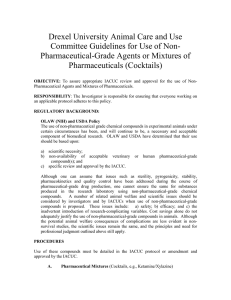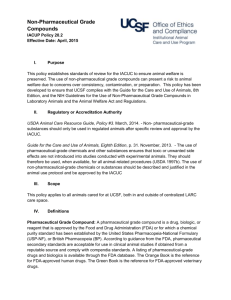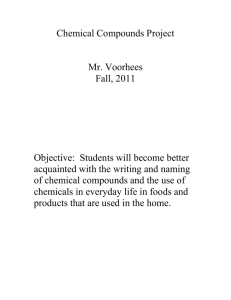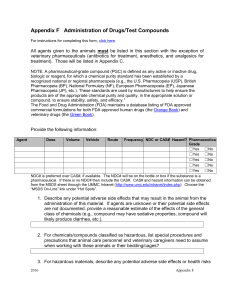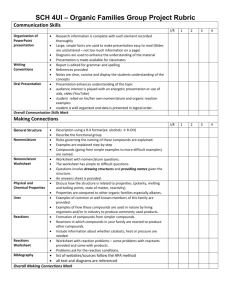Animal Care and Use Program Policy Use of Non
advertisement
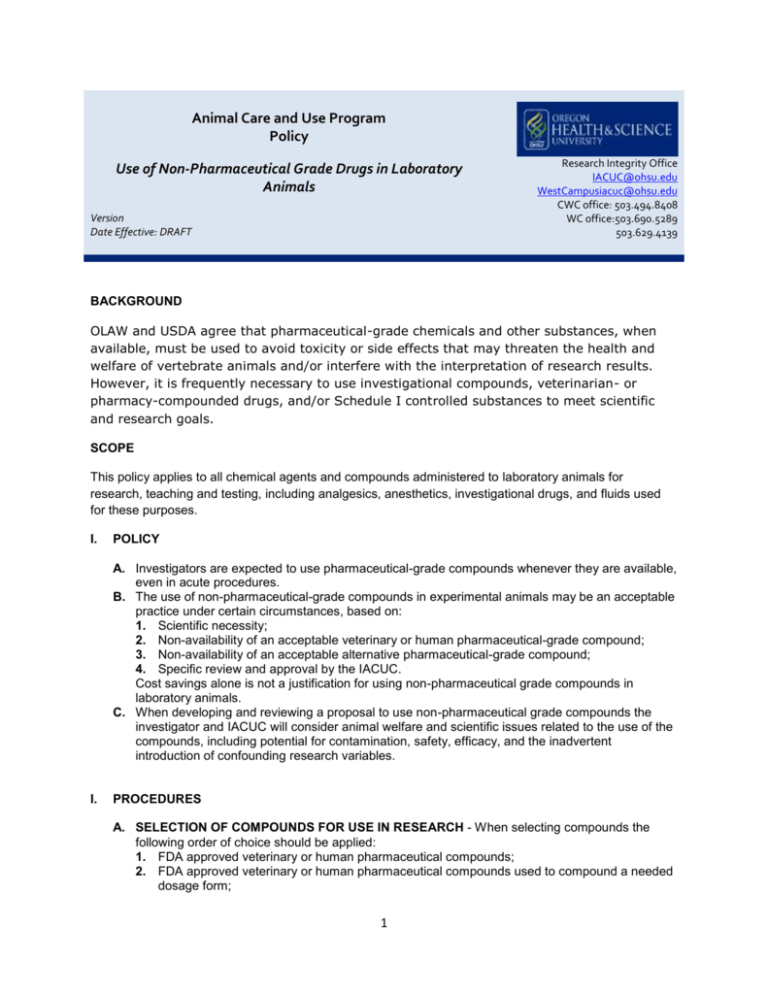
Animal Care and Use Program Policy Use of Non-Pharmaceutical Grade Drugs in Laboratory Animals Version Date Effective: DRAFT Research Integrity Office IACUC@ohsu.edu WestCampusiacuc@ohsu.edu CWC office: 503.494.8408 WC office:503.690.5289 503.629.4139 BACKGROUND OLAW and USDA agree that pharmaceutical-grade chemicals and other substances, when available, must be used to avoid toxicity or side effects that may threaten the health and welfare of vertebrate animals and/or interfere with the interpretation of research results. However, it is frequently necessary to use investigational compounds, veterinarian- or pharmacy-compounded drugs, and/or Schedule I controlled substances to meet scientific and research goals. SCOPE This policy applies to all chemical agents and compounds administered to laboratory animals for research, teaching and testing, including analgesics, anesthetics, investigational drugs, and fluids used for these purposes. I. POLICY A. Investigators are expected to use pharmaceutical-grade compounds whenever they are available, even in acute procedures. B. The use of non-pharmaceutical-grade compounds in experimental animals may be an acceptable practice under certain circumstances, based on: 1. Scientific necessity; 2. Non-availability of an acceptable veterinary or human pharmaceutical-grade compound; 3. Non-availability of an acceptable alternative pharmaceutical-grade compound; 4. Specific review and approval by the IACUC. Cost savings alone is not a justification for using non-pharmaceutical grade compounds in laboratory animals. C. When developing and reviewing a proposal to use non-pharmaceutical grade compounds the investigator and IACUC will consider animal welfare and scientific issues related to the use of the compounds, including potential for contamination, safety, efficacy, and the inadvertent introduction of confounding research variables. I. PROCEDURES A. SELECTION OF COMPOUNDS FOR USE IN RESEARCH - When selecting compounds the following order of choice should be applied: 1. FDA approved veterinary or human pharmaceutical compounds; 2. FDA approved veterinary or human pharmaceutical compounds used to compound a needed dosage form; 1 3. USP/NF or BP pharmaceutical grade compound used in a needed dosage form; 4. Analytical grade bulk chemical used to compound a needed dosage form (requires justification); 5. Other grades and sources of compounds (requires justification). B. CONSIDERATION OF NON-PHARMACEUTICAL-GRADE COMPOUNDS FOR USE IN RESEARCH - When the use of non-pharmaceutical-grade substances is proposed, the IACUC should consider the following factors in its decision whether or not to approve the use of the substance: 1. Grade/purity 2. Formulation of the final product 3. Quality control 4. Sterility 5. Factors that may contribute to adverse effects such as, but not limited to, pyrogenicity, stability, pH, osmolality, site/route of administration, pharmacokinetics, and physiological compatibility C. EXAMPLES FOR USE OF NON-PHARMACEUTICAL-GRADE SUBSTANCES - It would be reasonable for the IACUC to review, and the Committee may approve, the use of nonpharmaceutical-grade substances in the following situations: 1. If no equivalent veterinary or human drug is available for experimental use, then the highestgrade equivalent chemical reagent should be used and formulated aseptically and with a nontoxic vehicle as appropriate for the route of administration. 2. Although an equivalent veterinary or human drug is available for experimental use, the chemical-grade reagent is required to replicate methods from previous studies because results are directly compared to those of replicated studies. 3. Although an equivalent veterinary or human drug is available, dilution or change in formulation is required. a. If adulteration by dilution, addition, or other change in formulation is required, there may be no additional advantage to be gained by using the USP formulation. b. Use of the highest-grade reagent may have the advantage of single-stage formulation and also result in purity that is equal to or higher than the human or veterinary drug. c. Professional judgment should be used to determine the appropriate test material and to ensure use of an agent with the least likelihood for causing adverse effects. 4. The available human or veterinary drug is not concentrated enough to meet experimental requirements. 5. The available human or veterinary drug does not meet the non-toxic vehicle requirements for the specified route of injection. D. SPECIFIC COMPOUNDS SUBJECT TO INSTITUTION-WIDE POLICY 1. Pentobarbital sodium a. Recent exorbitant cost increases of pentobarbital have placed it logistically into the unavailable category. Pentobarbital from a reagent or analytical-grade powder, properly prepared by a pharmacist or other knowledgeable individual (e.g., chemist, veterinarian, researcher), with assurance of appropriate storage and handling, and approval by the IACUC is acceptable. b. For many species, adulteration by dilution, addition, or other change in formulation is required. Therefore, there may be no additional advantage to be gained by using the USP formulation. 2. Tribromoethanol (Avertin®) a. Avertin® is the trade name for the injectable anesthetic 2,2,2-tribromoethanol. Avertin® was once manufactured as a pharmaceutical-grade drug, but is no longer available. There are multiple reports in the literature of physiologic harm to animals including ileus, adhesions and mortality from the use of tribromoethanol. b. The preparation and use of tribromoethanol must be scientifically necessary, appropriately justified and approved by the IACUC. (a) Other injectable anesthetics, such as ketamine, xylazine, midazolam, and etomidate, which are available as FDA approved veterinary or human pharmaceutical 2 compounds, can provide similar planes of anesthesia and duration of action, and have fewer reported adverse effects than tribromoethanol. (b) Justification for using tribromoethanol should take into account the availability of commercially available pharmaceutical-grade alternatives and include a rationale for why these alternatives cannot be used. (c) Tribromoethanol is not controlled by the Drug Enforcement Administration (DEA); justification solely based on this fact, however, is not considered scientific or adequate. (d) Cost or convenience is not a scientific or adequate justification for the use of tribromoethanol. c. If tribromoethanol will be used for anesthesia, it must be properly prepared and stored. 2. Tricaine methanesulfonate (TMS, MS-222®, Tricaine®-S, Finquel®) a. Tricaine methanesulfonate is the anesthetic of choice for immersion anesthesia for most fish and amphibian species. It is a crystalline powder that can be dissolved in deionized water. It is available as a pharmaceutical-grade compound under the trade names Finquel® or Tricaine®-S. b. TMS concentrations above 500 mg/L should be buffered to neutral pH; use of unbuffered solution is acidic (1 g/L ~ pH 3.0) and is associated with skin irritation, stress and prolonged induction time. (a) Sodium bicarbonate can be used at 10-25 mEq/L. (b) 0.5 M dibasic sodium phosphate (Na2HPO4) can be used. 3. Urethane, α-chloralose, and chloral hydrate a. Urethane, α-chloralose, and chloral hydrate have been used as injectable anesthetic agents in laboratory animals, particularly rodents. They are not available as pharmaceutical-grade compounds. Although pharmaceutical-grade alternative anesthestics are available, urethane, α-chloralose, and chloral hydrate still have important roles as anesthetic agents in biomedical research due to unique physiologic effects (for example, urethane has minimal respiratory effects). b. Scientific justification should be provided for the use of urethane, α-chloralose, or chloral hydrate instead of commercially available, pharmaceutical grade injectable anesthetics. c. Use of urethane, α-chloralose, and chloral hydrate should be limited to terminal procedures. d. Urethane is considered a carcinogen and mutagen. Preparation, use, and disposition of this compound should take into account these hazards, and appropriate safety precautions should be reflected in the IACUC protocol, approved by Environmental Health & Radiation Safety, and implemented by laboratory personnel. 4. New investigational compounds a. New investigational compounds may be produced by a laboratory or supplied by a manufacturer for testing in an experimental setting only. Chemical purity standards are generally not established yet. Therefore, new investigational compounds are considered to be non-pharmaceutical grade with no available human or veterinary pharmaceutical grade equivalent or alternative. DEFINITIONS PHARMACEUTICAL-GRADE COMPOUND: A pharmaceutical grade compound is a drug, biologic, or reagent that is approved by the Food and Drug Administration (FDA) or for which a chemical purity standard has been established by the United States PharmacopeiaNational Formulary (USP-NF), or British Pharmacopeia (BP). According to guidance from the FDA, “pharmaceutical secondary standards” are acceptable for use in clinical animal studies if obtained from a reputable source and comply with compendia standards. A listing of pharmaceutical-grade drugs and biologics is available through the FDA database. The Orange Book is the reference for FDA-approved human drugs. The Green Book is the reference for FDA-approved veterinary drugs. ANALYTICAL GRADE BULK CHEMICAL: ~99% purity; Certificate of Analysis is usually available 3 NON-AVAILABILITY: Not commercially available from an active US vendor; includes formulations supplied as tablet, capsule, injectable, etc. NEW INVESTIGATIONAL COMPOUND: Supplied by its manufacturer for testing in an experimental setting only and for this reason would not have chemical purity standards established; by default is considered a non-pharmaceutical grade compound for which there is no acceptable hum FDA: Food and Drug Administration; FDA approved compounds are manufactured using USP/NF compounds AUTHORITY The Guide for the Care and Use of Laboratory Animals, 8th Edition, 2011 Animal Welfare Act REFERENCES U.S. Department of Agriculture, Animal and Plant Health Inspection Service, Animal Care, Policy 3Veterinary Care, April 14, 1997. Frequently asked questions about the public health service policy on humane care and use of laboratory animals. Wolff A, Garnett N, Potkay S, Wigglesworth C, Doyle D, Thornton V. Lab Animal (NY). 2003 Oct;32(9):33-6. United States Pharmacopeia website - http://www.usp.org/usp-nf OLAW Webinar, “Use of Non-Pharmaceutical-Grade Chemicals and Other Substances in Research with Animals”, March 1, 2012 OACU ARAC Guidelines, Animal Care Procedures Guideline #13: Guidelines for the Use of NonPharmaceutical Grade Compounds in Laboratory Animals, Revised 12/08/10. http://oacu.od.nih.gov/ARAC/documents/Pharmaceutical_Compounds.pdf 4
